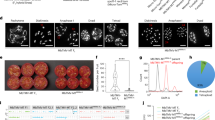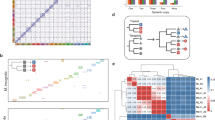Abstract
THE discovery of a tetraploid form of Primula farinosa on the Baltic island of Gotland during the summer of 1950 was somewhat unexpected, as hitherto this plant has seemed a well-defined diploid species (n = 9), at least in Central and Northern Europe. This tetraploid form revealed n = 18 at meiosis (Fig. 1), and the plant appeared morphologically distinct from the British Primula, with more elongated spatulate leaves (Fig. 4).
This is a preview of subscription content, access via your institution
Access options
Subscribe to this journal
Receive 51 print issues and online access
$199.00 per year
only $3.90 per issue
Buy this article
- Purchase on Springer Link
- Instant access to full article PDF
Prices may be subject to local taxes which are calculated during checkout
Similar content being viewed by others
References
Brunn, N. G., Sym. Bot. Upsal., 1 (1932).
Wright-Smith, W., Trans. Roy. Soc. Edin. (1949).
Author information
Authors and Affiliations
Rights and permissions
About this article
Cite this article
DAVIES, E. Polyploidy in Primula farinosa L.. Nature 171, 659–660 (1953). https://doi.org/10.1038/171659a0
Issue Date:
DOI: https://doi.org/10.1038/171659a0
Comments
By submitting a comment you agree to abide by our Terms and Community Guidelines. If you find something abusive or that does not comply with our terms or guidelines please flag it as inappropriate.



